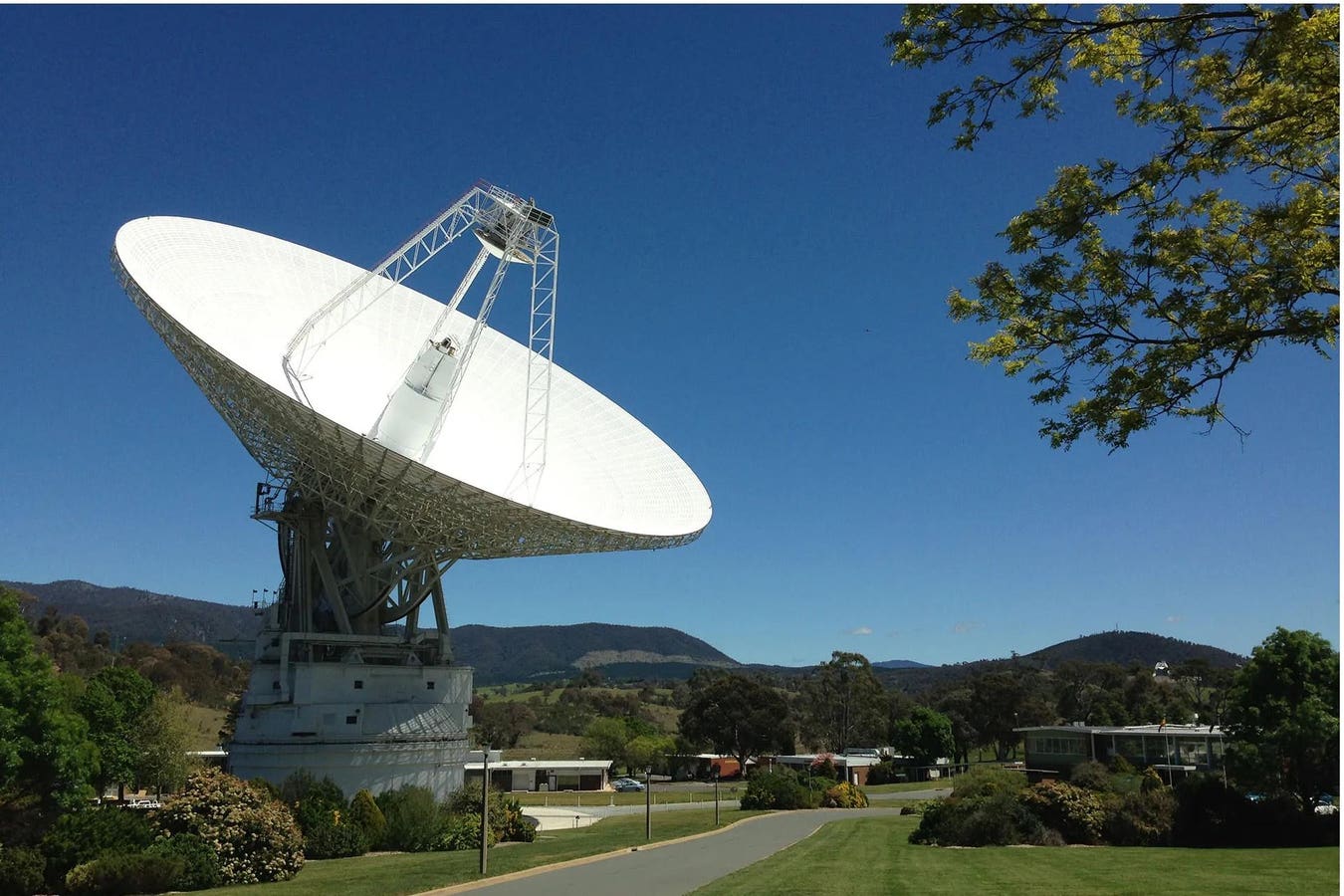Astronomers have been scanning the skies for alien radio signals for decades, but so far they’ve heard nary a peep (with one possible exception). But according to a recent study, that could be because they’re not looking in the right place at the right time. Pennsylvania State University astronomer Pinchen Fan and her colleagues searched 20 years of NASA’s deep space radio communications for clues about when and where our radio signals might be most visible to humans – and where we should look for theirs. The team published their study in The Astrophysical Journal Letters.
Deep Space Network, Deep Space Station 43 (DSS-43), a 230-foot (70-meter) antenna at the Canberra Deep Space Communications Complex near Canberra, Australia.
NASA/JPL/CALTECH
How To Eavesdrop On An Alien Space Program (If One Exists)
It makes sense that if there’s an alien species out there with more-or-less our level of technology, they might be doing some of the same things we’re doing: sending orbiters and rovers to explore the other planets in their star system, parking space telescopes at its Lagrange points, and keeping in touch with those spacecraft by radio. So the radio signals leaking out of a hypothetical alien star system might look a lot like the ones leaking out of ours.
“Considering the direction and frequency of our most common signals gives insights into where we should be looking to improve our chances of detecting alien technosignatures,” said Fan in a recent press release.
It turns out that NASA’s most powerful radio transmitters send signals to certain places in our Solar System – mostly Mars, with a side order of other planets and the JWST. We’re not just beaming signals out into the void and hoping someone’s listening, and we shouldn’t expect aliens to, either.
Fan and her colleagues studied 20 years of logs from NASA’s Deep Space Network, an array of radio antennas stationed at sites around the world, which NASA uses to keep in touch with its far-flung spacecraft. The DSN carries radio signals to and from the James Webb Space Telescope, Mars rovers, New Horizons, and the twin Voyager spacecraft – basically anything that’s beyond Low Earth Orbit, or more than about 2,000 kilometers away from Earth. Inevitably, some of those radio waves leak around the edges of their intended targets and keep going into space.
DSN’s transmitters are so powerful that aliens 23 light years away could probably pick up its stray radio waves from DSN (if they’re out there, and if they have radio telescopes similar to ours). But they’d have to be listening in the right place at the right time, according to Fan and her colleagues.
Here’s where and when the team of astronomers say we (and the hypothetical aliens) should be looking:
- SETI astronomers should look for star systems with habitable-zone planets within about 23 light years of Earth.
- We need to have an edge-on view of the star system, which means we should look for systems where we can see planets transiting, or passing in front of their host star from our viewpoint.
- And our absolute best chance of overhearing a signal will come when two of those exoplanets transit at the same moment, putting us in just the right spot to catch stray radio waves.
Mars (the bright object on the left) and Jupiter (the dimmer point of light on the right) are moving toward a conjunction in this 2018 photo, which means they’ll overlap in the night sky. This would have been a great time for aliens in the right spot to listen in to DSN transmissions. And that bright streak below the two planets is the trail of the International Space Station. (Photo by: Alan Dyer/VW Pics/UIG via Getty Images)
Universal Images Group via Getty Images
Eavesdropping Works Both Ways
Any hypothetical aliens’ best chance to eavesdrop on the DSN should happen when Earth and Mars are lined up on their night sky (picture a very tiny, very distant planetary eclipse), because NASA sends a lot of radio signals back and forth to Mars.
Most of the deep space radio signals in the DSN logs were sent to spacecraft orbiting Mars (like the Mars Reconnaissance Orbiter and Mars Odyssey) or rovers trundling around on the surface. Any stray radio waves that overshoot Mars just keep going in straight line from Earth to Mars to… whatever lies farther away along that line. Smart alien astronomers, then, would search for human radio signals on a night when Earth and Mars overlapped in their homeworld’s sky, putting their telescopes along the line DSN’s stray radio waves would be traveling.
That means, of course, that our hypothetical aliens would have to live on a planet whose star system is oriented the right way in relation to ours – which is just luck of the cosmic draw. Most of the planets (and even most of the smaller objects) in our Solar System orbit the Sun more-or-less in a flat disk. That means that when NASA is sending instructions to spacecraft at other planets, or even to JWST, it’s sending those transmissions along the disk, not out into space at random angles.
Alien SETI astronomers will have almost no luck at all unless they have an edge-on view of our Solar System. They might be left thinking our system was uninhabited – or at least that nobody here was smart enough to build a working radio. Meanwhile, astronomers here on Earth face the same problem. If there’s an alien species out there with its own versions of NASA and the DSN, we won’t have much luck eavesdropping on them unless their star system is oriented edge-on toward ours.
There’s an element of luck there, too, of course. An alien astronomers watching a transit of Earth and Mars together will have much better odds of detecting a signal than one watching a transit of, say, Venus and Neptune.
“If an extraterrestrial intelligence were in a location that could observe the alignment of Earth and Mars, there’s a 77% chance that they would be in the path of one of our transmissions,” said Fan, “Orders of magnitude more likely than being in a random position at a random time.” On the other hand, if those same aliens happened to be watching the skies when Earth and some other Solar System planet lined up, they’d have about a 12% chance of catching a stray radio transmission meant for a spacecraft like JUNO, which is in orbit around Jupiter (for now).
But the odds are still better than listening at random times, or to a star system that’s tilted the wrong way.
GREENBELT, MD- NOV 22: Workers in clean suits are next to the (R) Roman Telescope in the cavernous clean room that is 125 feet long, 100 feet wide and 90 feet high n Greenbelt, Maryland on November 22, 2024. NASA’s Nancy Grace Roman Space Telescope is being assembled at the NASA Goddard Space Flight Center. (Photo by Michael S. Williamson/The Washington Post via Getty Images)
The Washington Post via Getty Images
Timing Is Key, For Aliens And For Astronomers
Getting the timing right is a nearly impossible task right now, but that’s likely to change in the coming years. Astronomers have discovered very few star systems with two more transiting exoplanets; that’s part of why TRAPPIST-1 and its seven visible worlds are such a big deal. But if NASA launches the Nancy Grace Roman Space Telescope on time in 2027, that could change dramatically.
“With the upcoming launch of NASA’s Nancy Grace Roman Space Telescope, we expect to detect a hundred thousand previously undetected exoplanets, so our potential search area should increase greatly,” said Fan. That also means astronomers will be able to calculate those planets’ orbits, so they can predict when the planets will line up – and that’s the best time to listen for alien mission control talking to its version of the Curiosity Rover or the Voyager spacecraft.
In the end, that’s the really fun part about this whole idea – if we do manage to pick up a radio signal during future planetary alignments, we’ll probably be listening in to a species doing the same thing we’re doing: starting to explore its little cosmic neighborhood, wondering what else is out there in the beyond.
And maybe listening, too.









